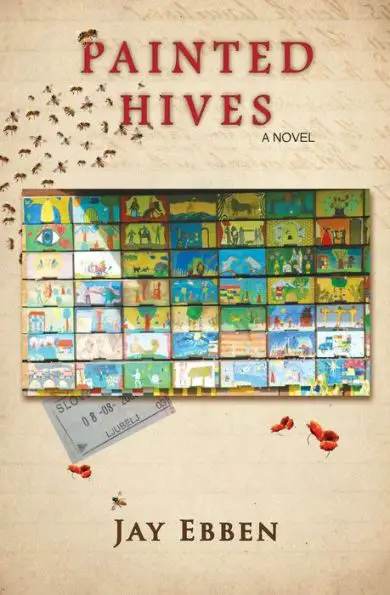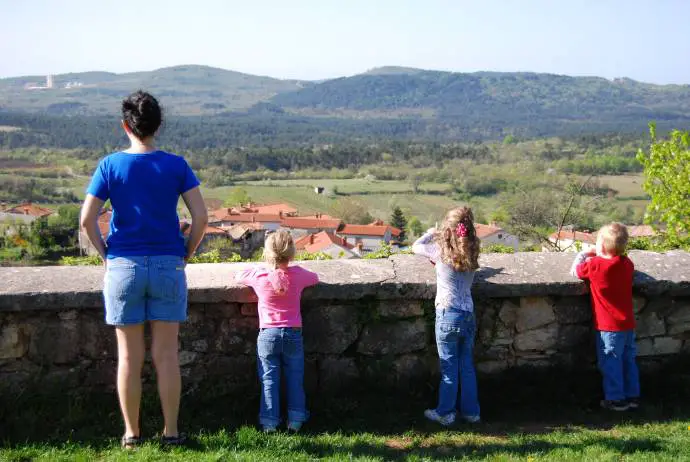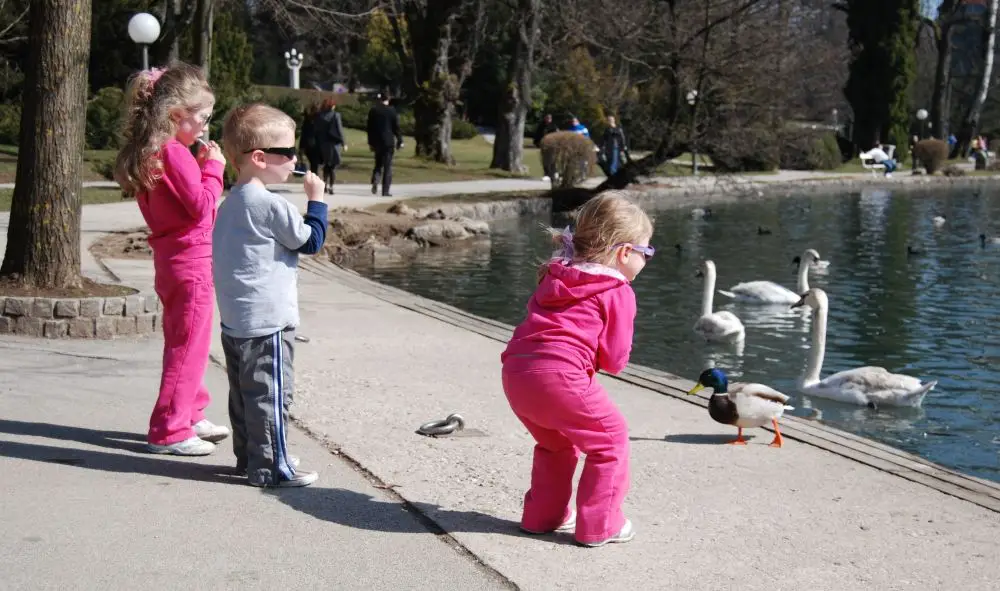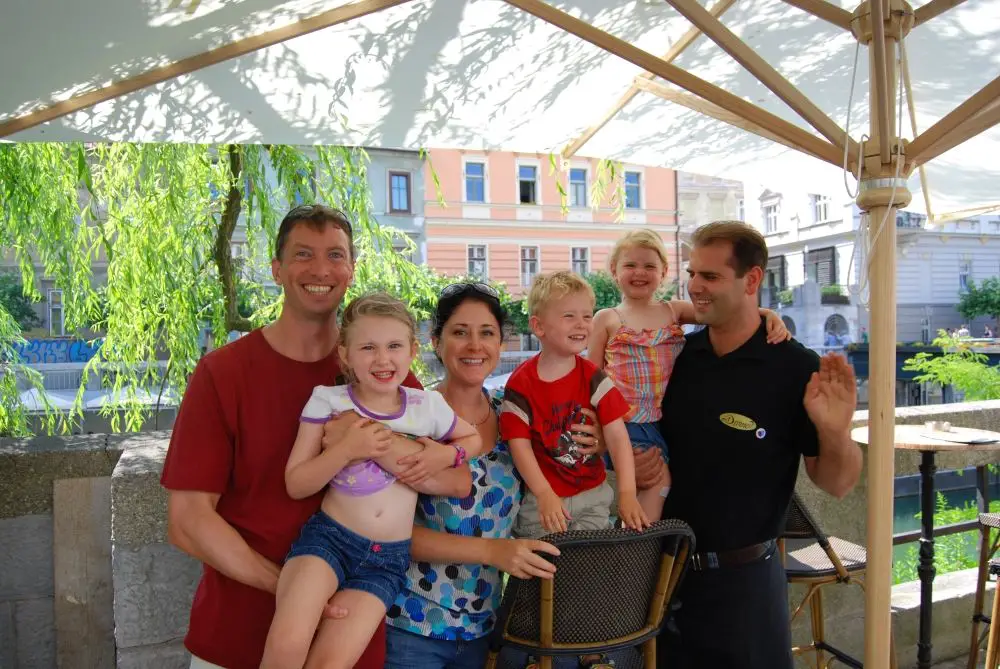April 18, 2018
Jay Ebben is an Associate Professor of Entrepreneurship at the University of St. Thomas in St. Paul, Minnesota. He and his family lived in Slovenia for five months in 2011 and they have returned five times since. His experiences in Slovenia inspired him to write Painted Hives, a novel about a boy who travels to Ljubljana to take a beekeeping class.
Part 1: Why Slovenia?
“You can relax now, you’re in Slovenia.”
This is what our van driver told us at Jože Plečnik airport after suggesting my wife and I leave half of our luggage on the sidewalk for his “friend” to pick up and bring into Ljubljana for us.
It was January 2011, we had just set foot in Slovenia for the first time, and we were going to be here for the next five months. We only knew one person in the country, didn’t speak the language, and didn’t have a place to live beyond the first week. And we had three jetlagged toddlers in tow, along with eight suitcases, a slew of carry-ons, a diaper bag, a double stroller, and three car seats. Way too many people and things to fit in the van.
My wife and I looked at each other thinking the same thing: “You have to be kidding.” But, we were tired and overwhelmed and it didn’t seem like we had much of a choice, so we strapped our kids in their car seats and got in the van, leaving half of our belongings there on the curb. Our adventure in Slovenia had begun.
I first heard of Slovenia at a conference in New Orleans back in 2004. I happened to be sitting next to a professor from the University of Ljubljana at a workshop, and the first workshop activity was get to know your neighbor. The professor leaned over and smiled. “Hi, I’m Mateja, and I’m from Slovenia. Do you know it?”
I tried to pretend that I did, but I’m sure it was obvious I didn’t, so she began telling me about it: that Slovenia was a tiny country at the tip of the Adriatic, that it had the beautiful Julian Alps, that it had only become an independent country thirteen years before. And the more she told me, the more curious I became.
When I got back to my hotel room after the workshop, I searched Slovenia on the web. The pictures that came up of Lake Bled and Triglav National Park and the Soča River and Ljubljana blew me away. And I found myself fascinated as I read about its rich history and culture. I told my wife, “This is a place we need to go someday.”
Five years later, I stumbled on an opportunity. I received an email about applying for Fulbright scholarships, which provide funding for academics and others to teach and research abroad.
When I asked my wife if I should apply for one, I half-expected her to punch me. Our oldest daughter had just turned two, and our twins were nine months old, and we had enough issues managing three kids in diapers here at home.
But she didn’t. She emphatically said, “Of course! Let’s do it now before the kids have started school.”
We needed to choose a country to apply to, and my wife and I came up with a list of 20 or 25 countries on our dream list. All of the usual suspects were there: Norway, New Zealand, France. Then one night, while looking at the list of countries on the Fulbright website, a light bulb went off. And I said to my wife, “What about Slovenia?”
We both loved the idea. I looked up Mateja, who now happened to be the chair of the entrepreneurship faculty at the University of Ljubljana, and sent her an email that said something along the lines of, “Hey, remember me?” And her reply was something along the lines of, “Um, sort of.” And then she agreed to write me a letter of invitation.
Luckily for me, Slovenia at the time was initiating many economic development programs around start-up companies, so as an entrepreneurship professor I was a great fit to go there. And in December of 2009, we received an email stating that I had been accepted for the 2011 spring semester.
The year leading up to our departure had been surreal. When we told people where we were going, they responded, “Where?” and then “Why?” and then “Isn’t that part of Czechoslovakia?” With three kids under the age of four, people thought we were nuts.
And it was hard for us to not think the same. I remember very clearly how much of a disaster our house was as we tried to pack for the five of us for winter, spring, and early summer, not knowing what we needed to bring versus what we could get there, trying to be prepared for all types of weather, and wanting to have at least a few toys to keep our kids reasonably occupied.
And all of this was on top of the fact that Mateja was the only person we knew in Slovenia (and the truth was, we really didn’t know her) and we weren’t sure how we were going to find a place to live. We seriously found ourselves wondering whether this was the kind of thing responsible parents do.
So, when we arrived in Slovenia and the second thing that happened (the first was our youngest daughter throwing up on the airport floor) was deciding to leave our luggage on the sidewalk at the airport, we really began to question our judgment.
But something about the way our van driver suggested it, in a sort of nonchalant, nothing-out-of-the-ordinary manner, made me feel like maybe that was just how things were done here. That maybe that’s just how people operated, based on their word and simply doing the right thing. That not delivering our luggage to us wasn’t even up for consideration. And a half-hour after we arrived at our first-week apartment, our driver’s “friend” showed up with our luggage, as promised.
That same evening, we had a similar experience. I walked down Trubarjeva looking for take-out (which didn’t exist), and found myself in a tiny restaurant asking if I could get some soup to take back to our apartment. The woman at the restaurant said, “Of course,” and then brought it out in a nice storage container that was clearly not meant to be taken home. “You can just bring this back tomorrow,” she said, casually, as if to not burden me with having to return the container that evening and as if it never occurred to her that a person would do anything other than return it that evening if she didn’t say it. At that moment, I knew I was going to love living here.
This was the beginning of a magical experience for all of us. We ended up staying in an attic apartment in old town just below the castle, which had a spiral staircase that became our kids’ indoor playground. We walked to the open-air market every day to buy groceries and had ice cream cones and cheese toast at a café on the river each afternoon. We took a train to Ptuj for the opening parade of Kurentovanje, spent a weekend at a tourist farm in Tomaj, explored the caves in Postonja, and much, much more.
Of course, not everything was easy. Our apartment building didn’t have an elevator, so we hauled groceries and strollers up five flights of stairs every day. For the first two months, we walked forty-five minutes to the Interspar to buy toilet paper and diapers, not realizing there was a store just a few blocks from us that had everything we needed. It was an adventure every time we got in the car because I didn’t know how to drive a stick. And we visited the emergency room more than once.
But we loved it. All of it.
And what we loved most were the people. We met some of the most genuine, hospitable people (including our van driver and his “friend”), and have become lifelong friends with many of them. As just one example, a professor I met at the University offered out of the blue to take our family to the Soča River valley for a weekend, and he and his wife drove us there in two cars and spent that weekend taking us around to their favorite sites. And as repayment, our son threw up in the backseat of their brand new car, but that’s another story.

Leaving Slovenia that June was one of the most difficult things I have ever had to do. At the time, we had no idea when or if we would ever be back, when or if we would ever get to see our new friends again. I remember trying to say goodbye to a waiter at one of the cafes on the river with whom we had become great friends, and not being able to get the words out.
Then, the following February, something crazy happened. My wife was going through the pockets of her winter coat and found the business card of a woman we had met at the U.S. Embassy in Ljubljana. And she and I started reminiscing about our five months in Slovenia and talking about how much we wished for an opportunity to go back.
We hadn’t spoken to the woman from the Embassy since we had left, but finding her business card must have sparked something because the very next morning I received an email from her asking if I would teach in a new program they were offering that summer. I replied, “YES!!!” in capital letters with three exclamation points. That program, called the Summer Economics Institute, has brought us back to Slovenia five times in the past six years and will bring us back again this summer.
It is amazing to think that all of this started with a “chance” meeting at an academic conference in 2004 and a random email I received five years later about the Fulbright Program. Slovenia has come to hold such a big place in our hearts (so big, in fact, that I found myself cheering for the Slovenian hockey team this past February), it is tough to imagine how different our lives would be without it.
Part 2: “No beekeeper I know has allergies”
If you want to take a closer look at Jay’s book, Painted Hives, then you can do on the related website, where there’s also a page that tells you where you can pick up a copy (and you can try the first few pages on Amazon or Barnes & Noble if you have a Kindle or similar device).









